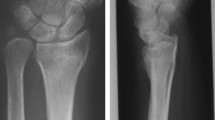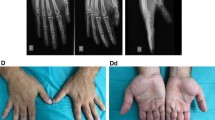Summary
Pseudoarthrosis and cubitus valgus as main complications following displaced fractures of the radial condyle in children can be prevented by open reduction and fixation by K wires. However, delayed union and stimulation of the radial physis with condylar overgrowth and varisation of the elbow as well as fishtail deformities of the distal end of the humerus are reported nevertheless. To prevent those growth disturbances all primary and secondary (4-day X-ray control) displaced fractures of the radial condyle, i. e. those with a central gap of more than 2 mm, were prospectively treated by open reduction and osteosynthesis with a metaphyseal lag screw beginning 1974. Sixty-six patients (41 boys, 25 girls) with an average follow-up of 10 years (2–22 years) sustained 28 primary and 6 secondary displaced fractures. In 5 cases a K wire fixation was performed in view of the smallness of the fragment. Two children with conservative treatment following overlooked displaced fractures showed condylar overgrowth and varisation of the elbow. Screw osteosynthesis led to symmetric elbow angles and function in all cases, whereas fishtail deformities could be observed in 8 of 27 children, probably as a consequence of the remaining central fracture instability. Conclusion: Open reduction and osteosynthesis with a metaphyseal lag screw prevents condylar overgrowth in displaced fractures of the radial condyle by guaranteeing fracture healing in anatomic position within 3–4 weeks. However, fishtail deformity can not be prevented by metaphyseal compression only.
Zusammenfassung
Obwohl Pseudarthrosen und Cubitus valgus als Hauptkomplikationen der dislozierten Condylus-radialis-Fraktur im Wachstumsalter durch offene Reposition und eine Adaptationsosteosynthese mittels Kirschner-Drähten verhindert werden, kann durch verzögerte Konsolidation eine Wachstumsstörung im Sinne einer partiellen radialen Fugenstimulation mit kondylärem Mehrwachstum, Varisierung der Ellbogenachse und Einziehung der Notch (Fischschwanzdeformität) auftreten. Seit 1974 werden daher an unserer Klinik prospektiv alle primär und sekundär (gipsfreie 4-Tages-Kontrolle) dislozierten Frakturen, d. h. Brüche mit einer zentralen Aufweitung von mindestens 2 mm, mittels offener Reposition und metaphysärer Zugschraubenosteosynthese versorgt. Bei insgesamt 66 Kindern (41 Knaben, 25 Mädchen) mit einer durchschnittlichen Nachkontrollzeit von 10 (2–22) Jahren fanden sich 28 primär und 6 sekundär dislozierte Frakturen, welche alle regelrecht konsolidierten. In 5 Fällen mußte wegen der Kleinheit des Fragments eine K-Draht-Osteosynthese durchgeführt werden. Bei 2 Kindern führte eine übersehene sekundäre Dislokation mit konservativer Therapie zu einer Ellbogenvarisierung. Alle Patienten mit Schraubenosteosynthesen zeigten symmetrische Ellbogenachsen und -funktion. Fischschwanzdeformitäten, wahrscheinlich als Folge einer verbliebenen zentralen Instabilität, konnten nach Osteosynthese bei 8 von 27 Kindern beobachtet werden. Schlußfolgerung: Die offene Reposition und metaphysäre Zugschraubenosteosynthese bei dislozierten Frakturen des Condylus radialis humeri verhindert zuverlässig das kondyläre Mehrwachstum bei anatomischer Frakturheilung innerhalb 3–4 Wochen. Zur Vermeidung von Fischschwanzdeformitäten muß eine zusätzliche quere, die Trochlea miteinbeziehende Fixation mittels Kirschner-Draht diskutiert werden.
Similar content being viewed by others
Author information
Authors and Affiliations
Rights and permissions
About this article
Cite this article
Hasler, C., von Laer, L. Schraubenosteosynthese bei dislozierten Frakturen des Condylus radialis humeri im Wachstumsalter. Unfallchirurg 101, 280–286 (1998). https://doi.org/10.1007/s001130050269
Published:
Issue Date:
DOI: https://doi.org/10.1007/s001130050269




